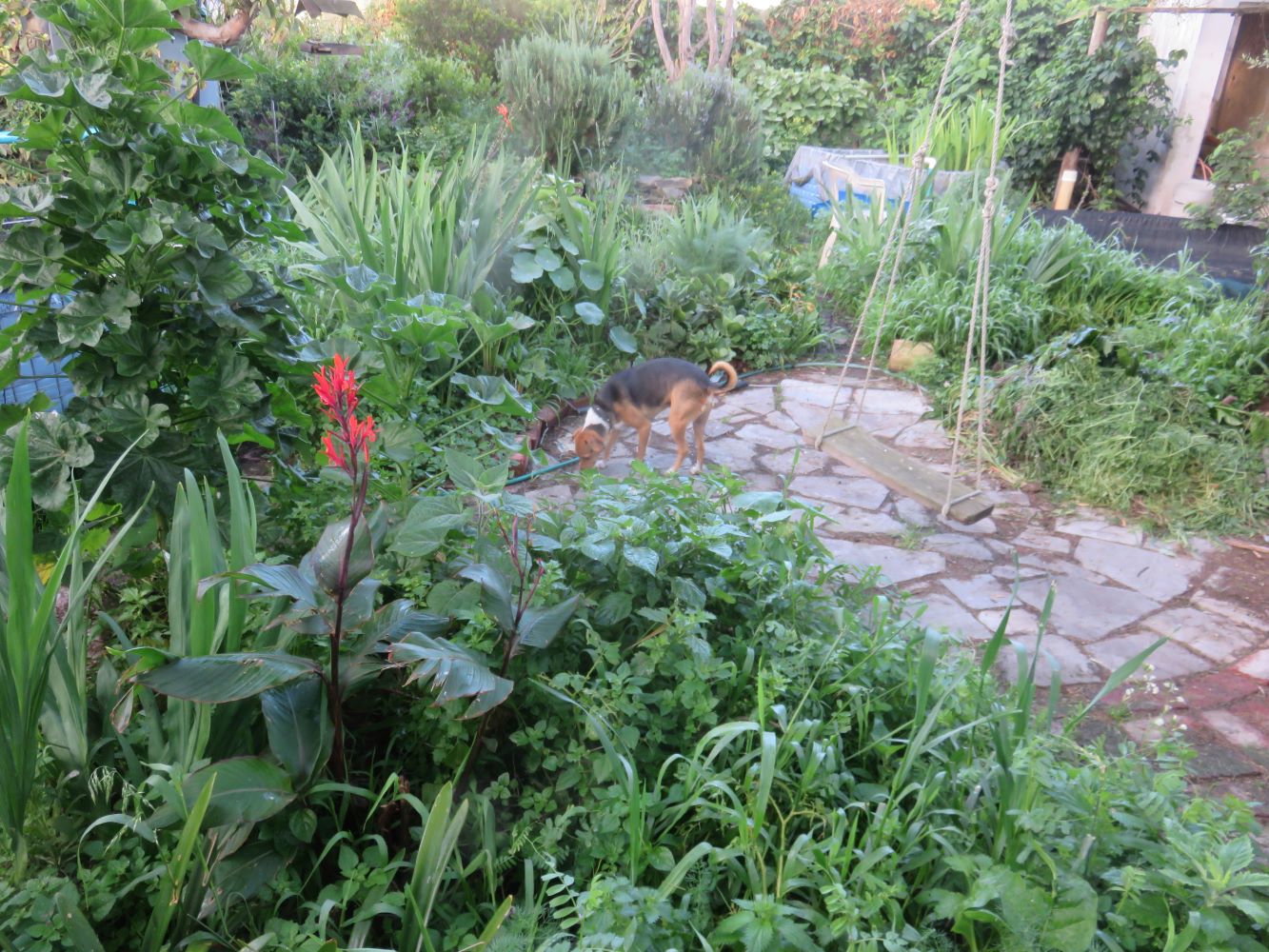Dear Reader, in this age of AI created content, please support with your goodwill someone who works harder to provide the human-made. Sign up in the righthand column or bottom of this page. You will receive my hand illustrated monthly newsletter RESTORE NATURE and access to the biodiversity garden design course as I write...and nothing else, I respect your time.
Sourcing gardening water: where to start
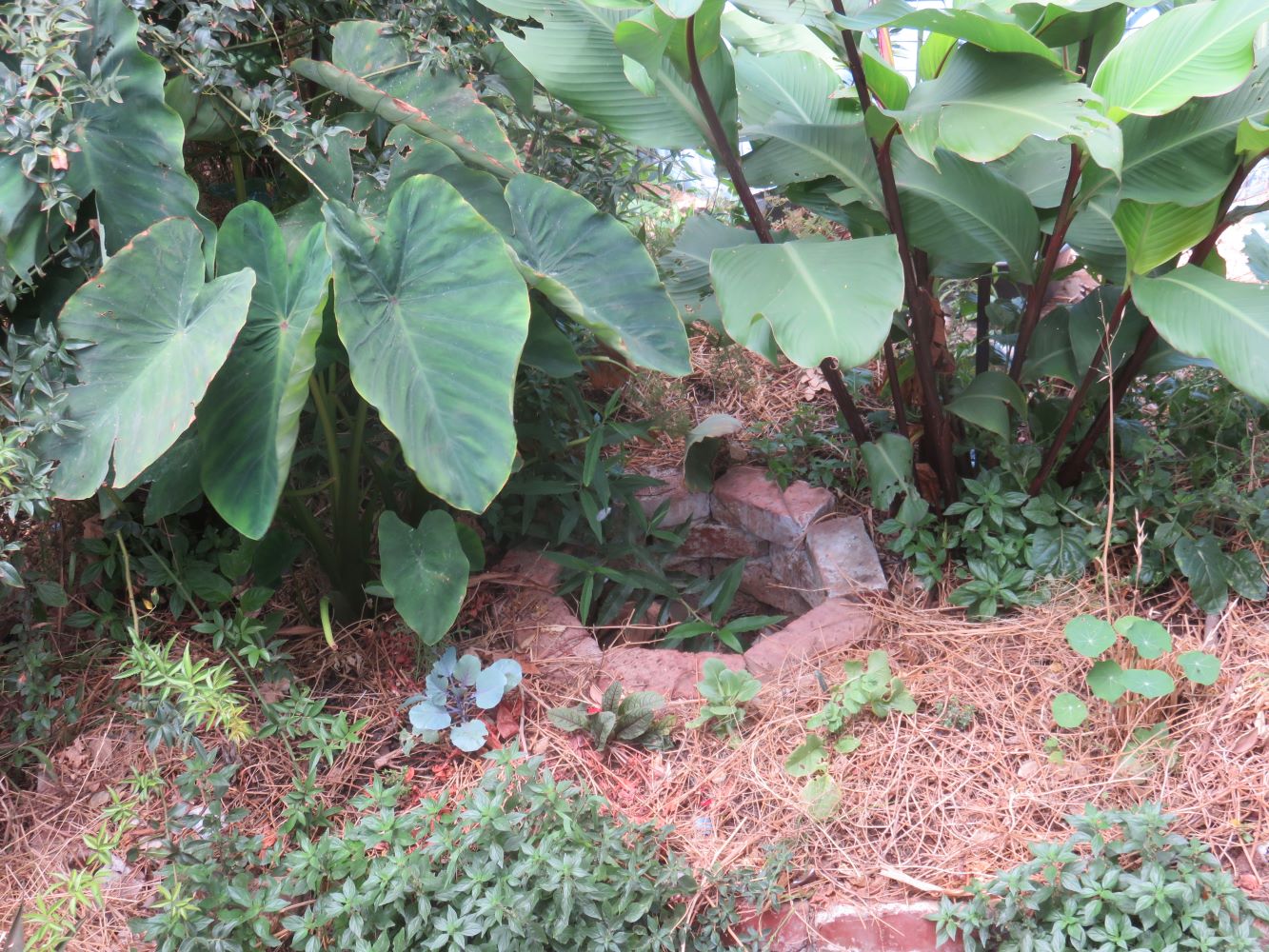 A benefit of my early attempts to source steady supplies of gardening water was building two grey water recycling systems.
A benefit of my early attempts to source steady supplies of gardening water was building two grey water recycling systems.Gardening, an opportunity to change.
Finding gardening water in nature rather than from the city mains, presents us with the opportunity to apply regenerative principles and leverage enormous benefits for the environment. With regenerative gardening, we as individuals can combat malnutrition and food insecurity, species diversity loss, soil loss, landscape dehydration, drought, soil fertility loss, local flooding and global warming. These can all be accomplished by the methods needed to create healthy living soil.
A special regenerative angle
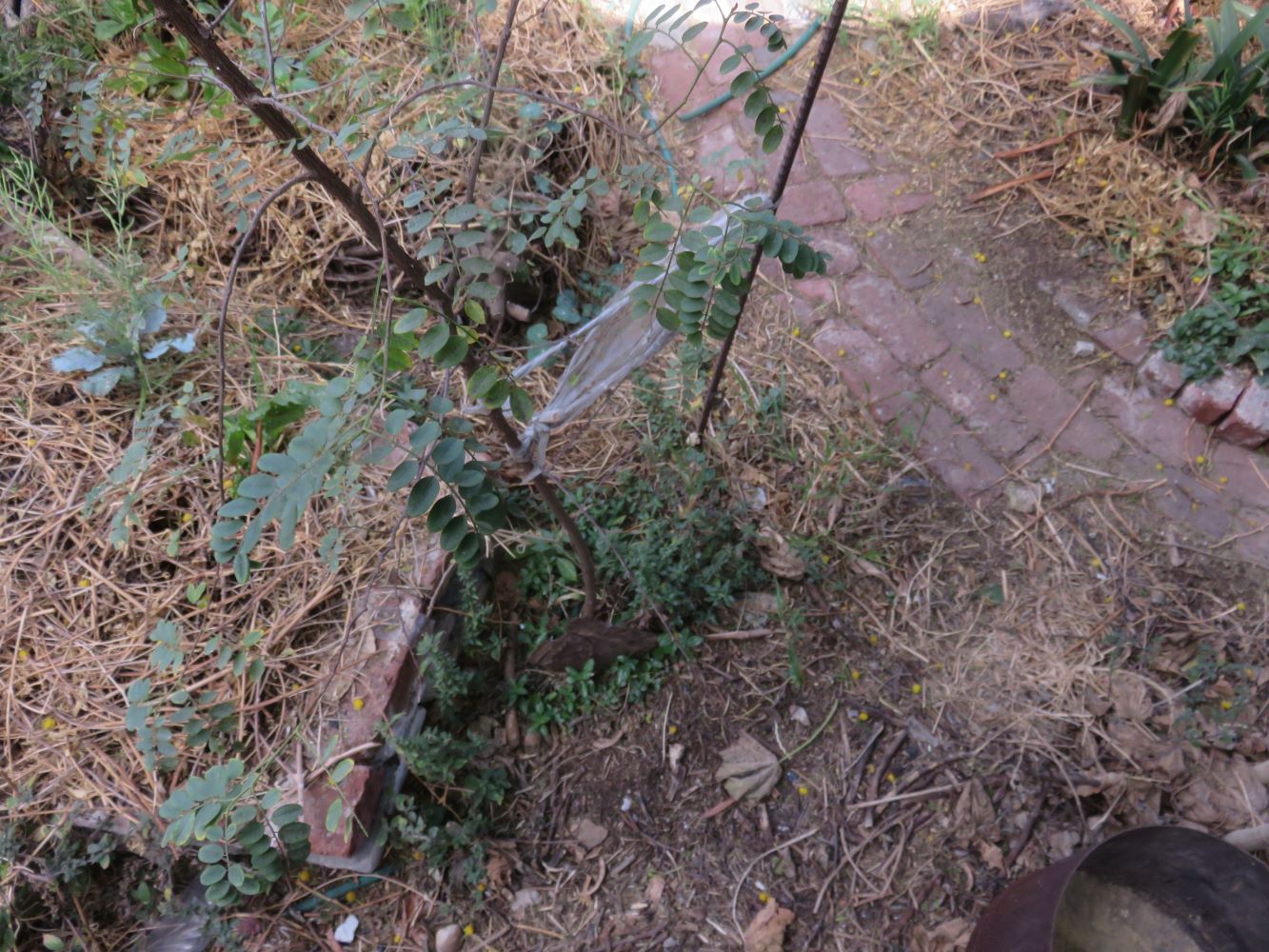 The first blind spot. This indigofera tree is planted on a slope, with the hard paved path removing water from it. I cannot believe I missed this.
The first blind spot. This indigofera tree is planted on a slope, with the hard paved path removing water from it. I cannot believe I missed this.Gardening is an iterative process. I return again and again to water. I originally started with 'water wise' gardening in a big way, which I understood as planting only natives. It was really successful and the garden was green all year with no irrigation. Then I studied permaculture and started to obsess about the plantings being edible. I also built two giant grey-water wicking beds. It seems I'm recycling the water issue again, but not with the focus on using less water, this time.
I recently
re-discovered something very useful that is an important part of
regeneration which should not be missed, but which I managed to
overlook somehow. Analyzing my soil microscopically showed me this
and literally opened my eyes to its importance. Gardening water is the elephant
in my particular garden room. Without its sufficiency, the perennial
native planting, organic mulch, diverse cover crops and no
disturbance regime of regenerative gardening will probably not
increase the life in my soil. The regenerative canon says it is harder to establish living soil on pure sand, and with 6 month long dry spells every year. I really could help my garden and lessen the impact of drought, but I was so focused on native planting I had a blind spot about what rain water was doing in the garden.
Free gardening water is the best
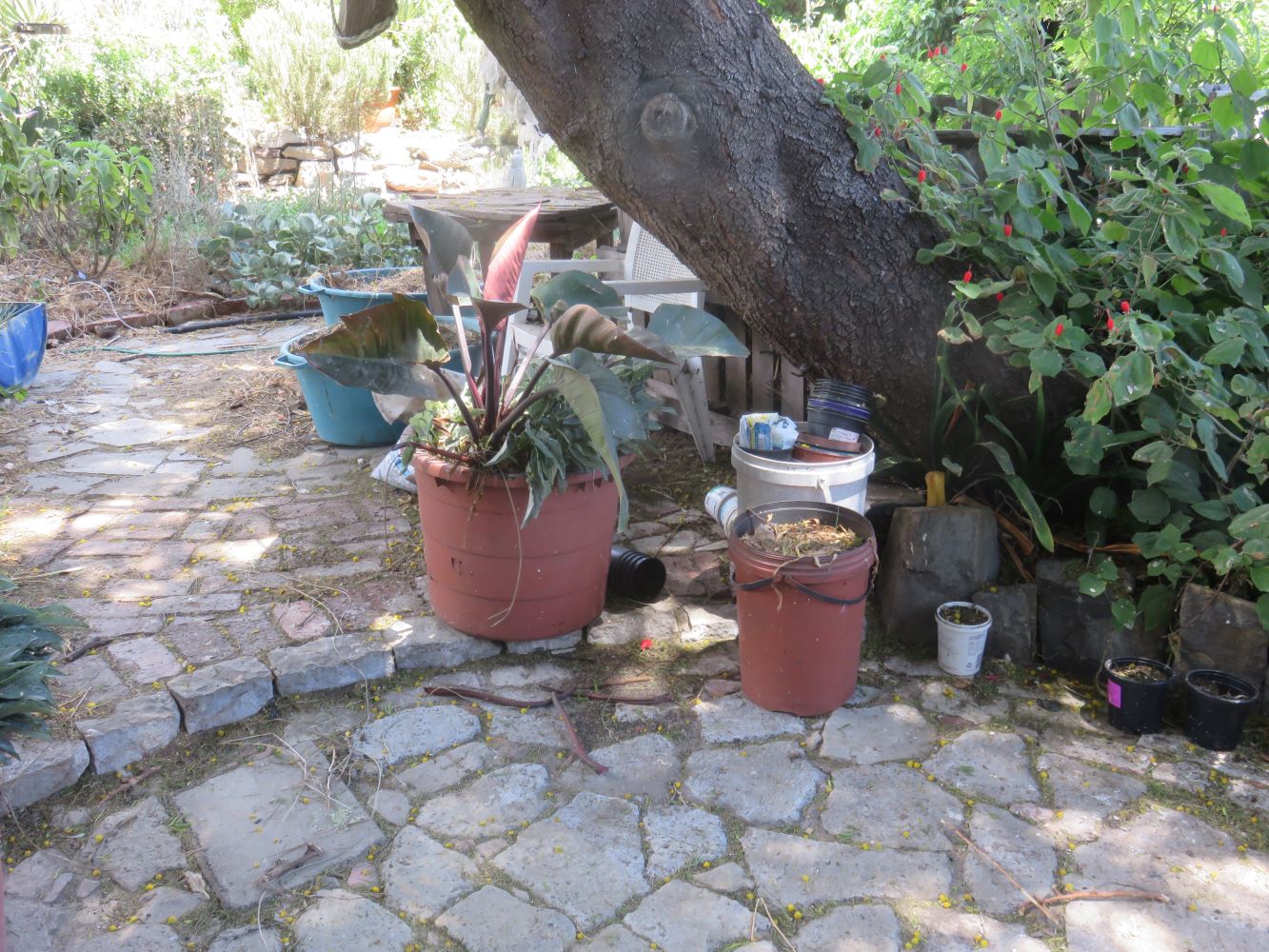 The second blind spot. Large areas of my garden are paved, and the paving is lower than the planted beds !
The second blind spot. Large areas of my garden are paved, and the paving is lower than the planted beds !But turning on the hose is not the way to supply the gardening water I need. It creates enormous problems on a macro level, such as wastage of scarce drinking water on irrigation, and the depletion of aquifers. On a micro level, the chlorine in the drinking water in the mains that we use to irrigate our plants will kill the soil organisms. This will mean the soil sponge will begin to break down, if it is not already compacted, and this will produce further degradation of the soil.
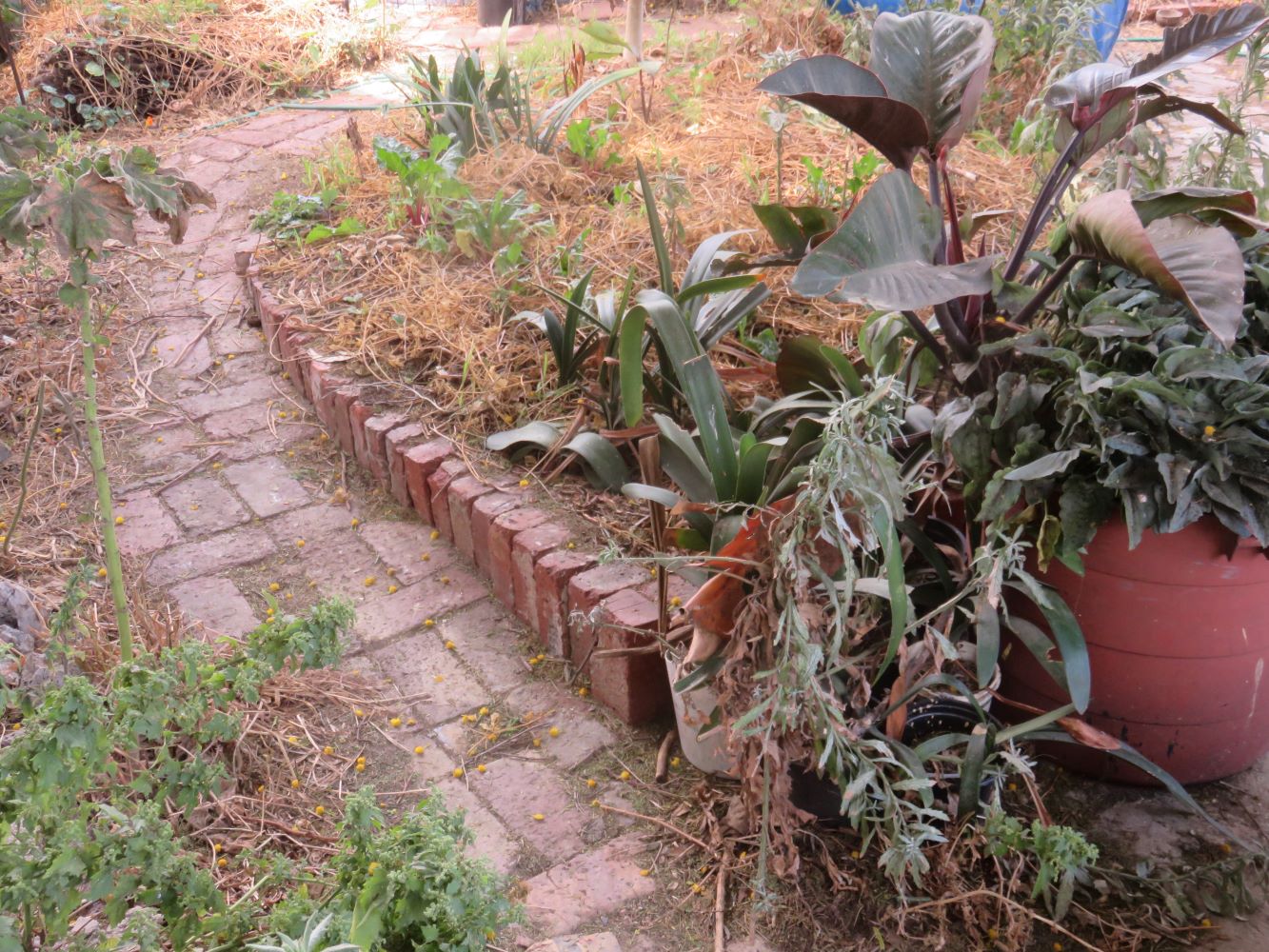 Another example where the bed is above the paving.
Another example where the bed is above the paving.What is the most soil friendly way to introduce more water to the system ?
What was I to do, now that my eyes had
been rudely opened by finding no life in my garden soil, and plenty
in my wetlands ? As I work through finding solutions, I realize
supplying water to plantings requires a complete rethink of the
planting process to maximize using the available rainfall. My head
almost hurts. The issue is so simple, but complex enough that if one is a bit distracted by other issues one may miss it. I've made so many mistakes, as the pictures show.
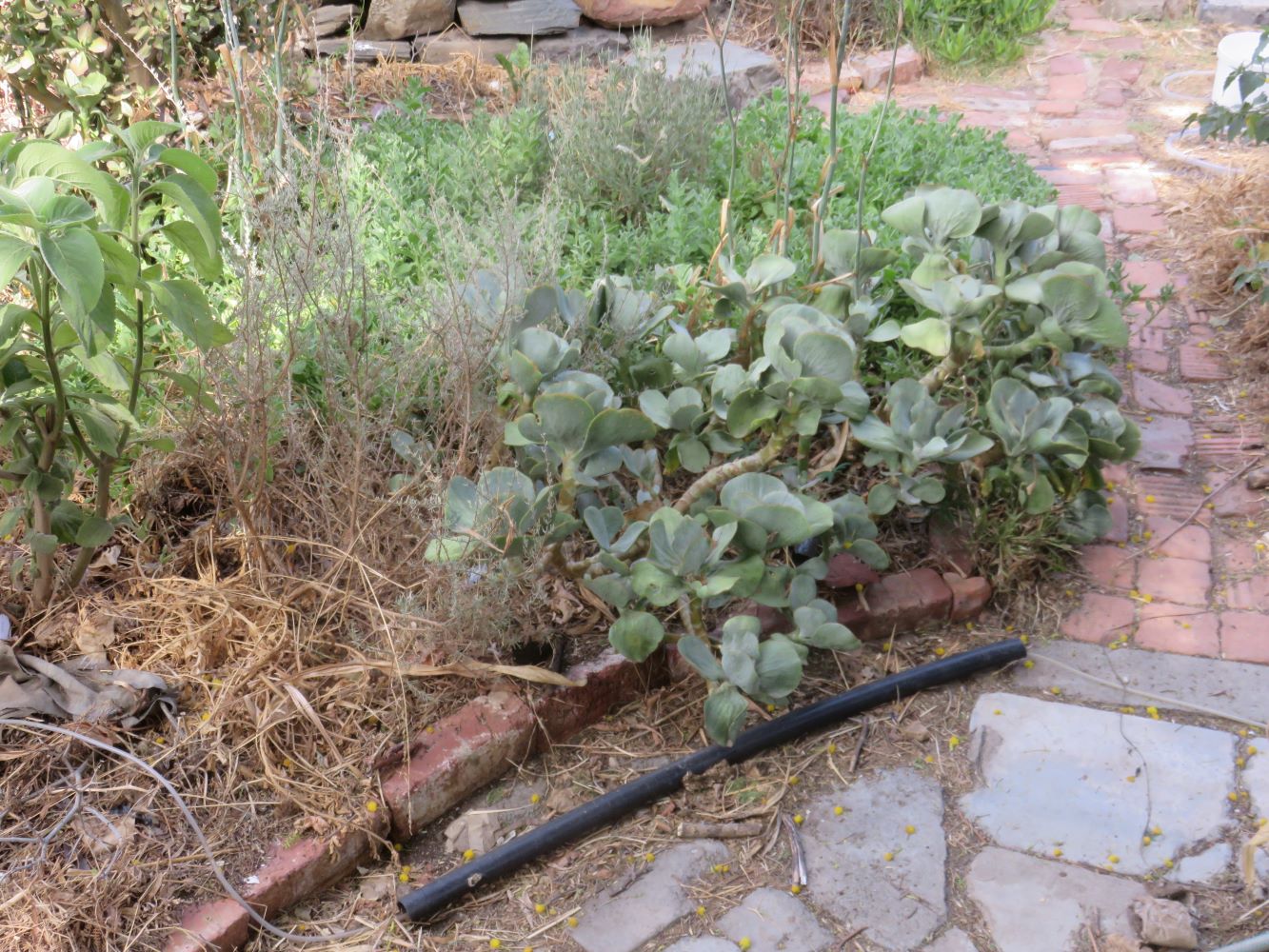 Once again the paths are like canals between the slightly higher planted beds.
Once again the paths are like canals between the slightly higher planted beds.Planting rain gardens
Brad Lancaster, the advocate of 'planting the rain' who grew up in the Sonoran desert in Arizona made this amusing statement, if it wasn't so sad. 'People love to plant trees', he said, 'but first you must plant the rain, or the trees will die'. This is especially true in our dry climates. I looked at struggling and dead trees in my garden and elsewhere, and I'm sure you know what I found. I had somehow just lost this thing from sight when I planted. I cannot point fingers at the city of Cape Town's planting disasters anymore.
'Planting the rain' means designing the contours and environment of your planting so that the place you are going to plant collects the maximum amount of rainwater. Planting the rain is most simply accomplished by planting in hollows and not on bumps. Another way to see this is to visualize a muffin pan. When it is upside down, and you plant on the bottom of the cups, water will drain away from your plants. When it is the right way round and you plant inside the cups, water will be caught around the plant. To amplify your catchment of water, lead the runoff from nearby hard surfaces into the hollows you have created to plant in. Actually look out for these surfaces and leverage every drop they shed and think of gardening water before you garden plants.
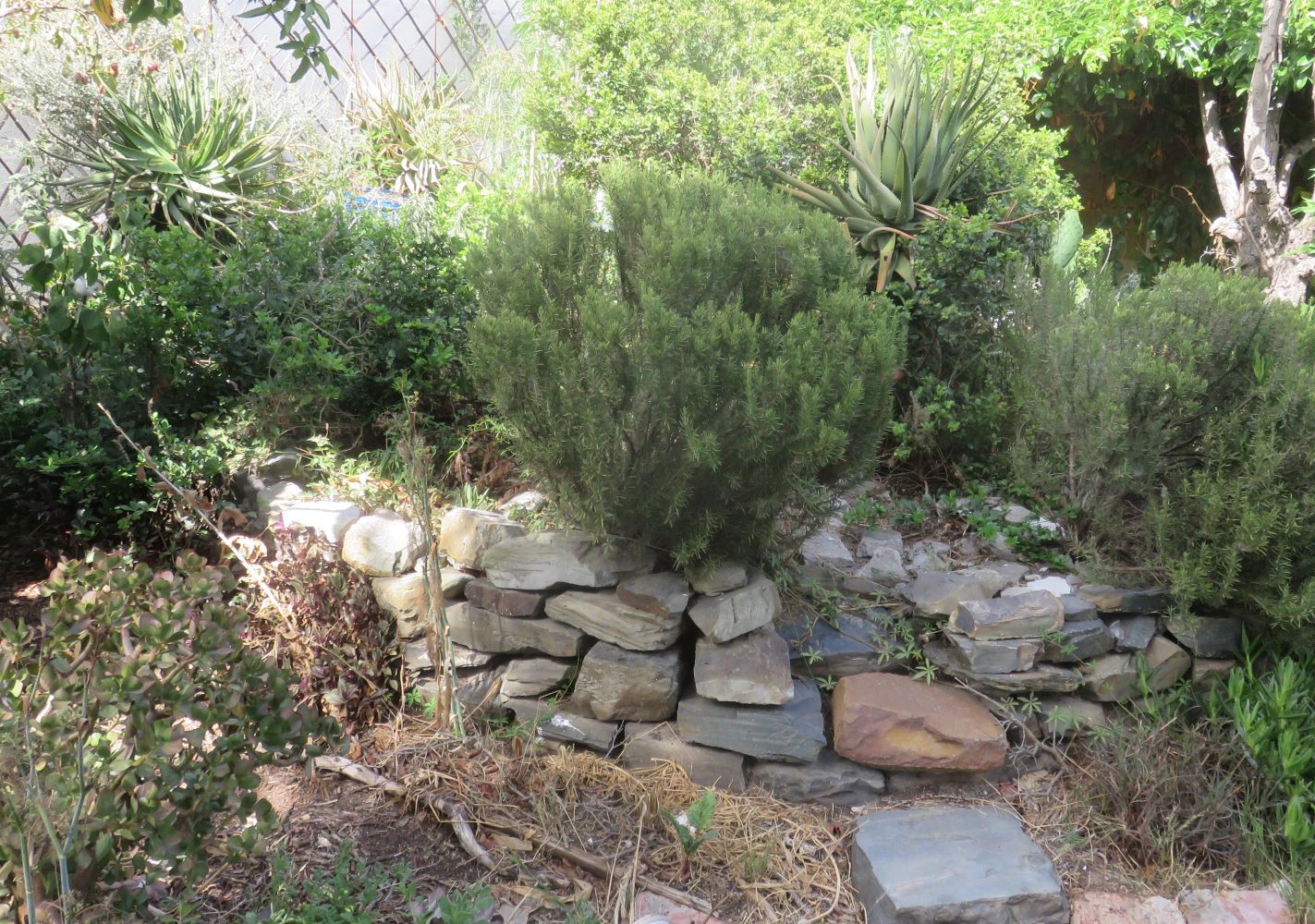 And this is the worst example of all. A large area of the garden surrounded by a dry wall and raised above the rest. Our fig sapling and even olives have died here.
And this is the worst example of all. A large area of the garden surrounded by a dry wall and raised above the rest. Our fig sapling and even olives have died here.Brad Lancaster caught a phenomenal amount of rain when creating public verge gardens by leading the runoff from the road into sunken beds he calls rain gardens. Native trees and permanent plantings are adequately irrigated by seasonal rain this way. He turned bleak dust verges into what looks like a botanical garden. Planting the rain makes the plantings independent of piped water. If done on a large scale it also helps re hydrate landscapes. That means soil water increases, the water table rises, and if enough people do it, rivers that have dried up will run again, and wells will be full.
Zephaniah Phiri in Zimbabwe did this by catching the runoff from a giant rocky hill, and leading it into pits in the ground. The water in these pools slowly seeped into the ground water. He gradually built many kinds of structures with his hands that helped sink rain water into the soil, and accumulated a bible of techniques. This activity led to full wells and wetlands and a farm bursting with tropical fruit in an area that had formerly been marginal and given to seasonal famines. But the regeneration process took decades.
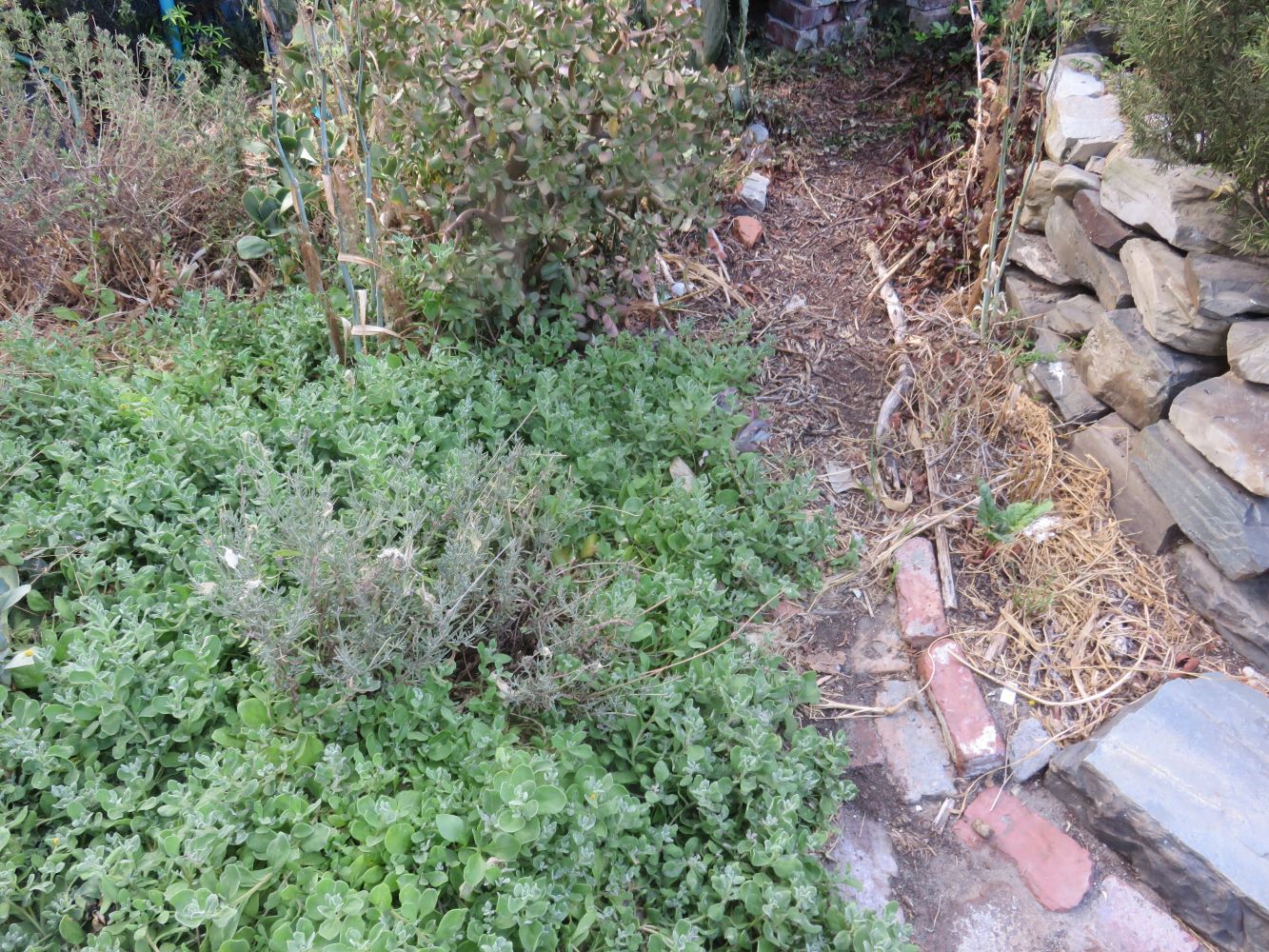 And below the wall, in the water catching hollow of the garden, I planted hardy native plants instead of the more tender European ones.
And below the wall, in the water catching hollow of the garden, I planted hardy native plants instead of the more tender European ones.Small scale changes
These miracles are do-able on a very small scale on verge and garden. It is just a matter of adjusting one's thinking to the will of water and what it does and where it flows.
Indigenous plant knowledge
Using the rain fully requires another major mental adjustment. Rain is supplied naturally in a region with a certain rhythm. Local plants and wild life have adapted to this. So planting native plants and plants that thrive in nature in similar water supply micro-climates will mean the plants thrive. Thriving plants build soil. To use native plants requires learning about native plants: which are edible, useful and contribute in some way to the planted ecosystem, and exactly where they grow on the slope to the water bodies. In all countries in the world there seems to be a loss of localized plant knowledge.
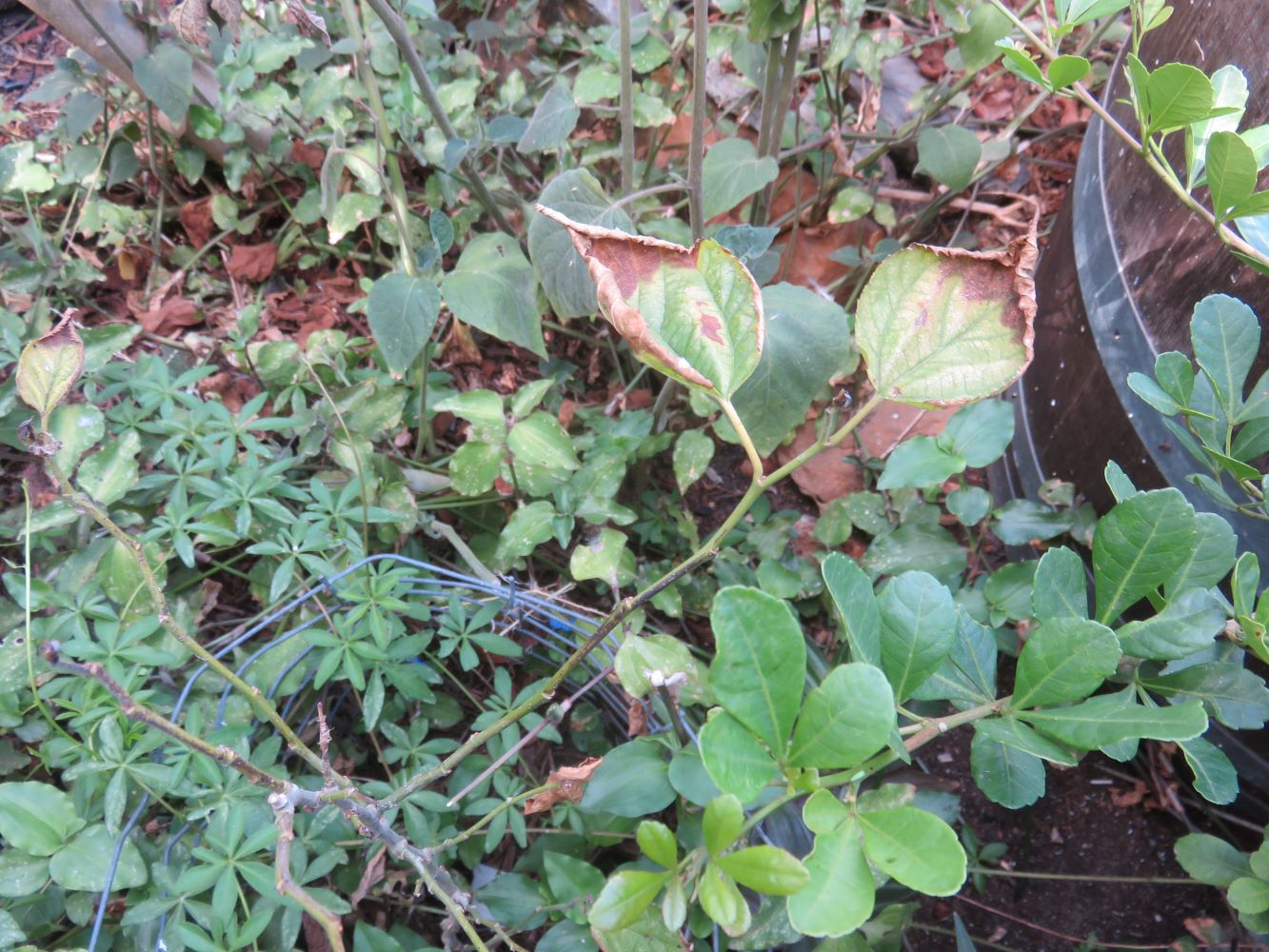 The mulberry on the lower slope of the huge raised bed is always struggling and sick.
The mulberry on the lower slope of the huge raised bed is always struggling and sick.Brad Lancaster also had to overcome this type of problem set. He did a lot of research in the ethnographic record on what plants were used and thrived in the Sonaran desert environment, and did a lot of hiking and making notes in the wild. He helped revive the use of 'mesquite' and made it a hot new thing. Zephaniah Phiri also reintroduced 'lost' vegetables that had traditionally been used in the Zvishavane district in Region 4 of Zimbabwe. They had been supplanted by exotics which failed.
South Africans have similar problems. We think of food plants usually as the imported European vegetables and fruit. We really need to adjust our paradigms as our taste for fertilizer and water hungry European vegetables in this climate where they are not at home is so destructive to the environment. Must food growing involve inputs and hassle ? Can we imagine food plants as delicious delicacies indigenous to the Fynbos, growing with the vigor of weeds on just what nature gives them. I don't think we can, yet.
The trouble is if we do change our mindsets about indigenous food plants, only a tiny percentage of the potential edibles are available for sale as plants or seed. This may be the biggest hurdle and its why I am growing native food trees in my nursery to donate to pavement greening projects.
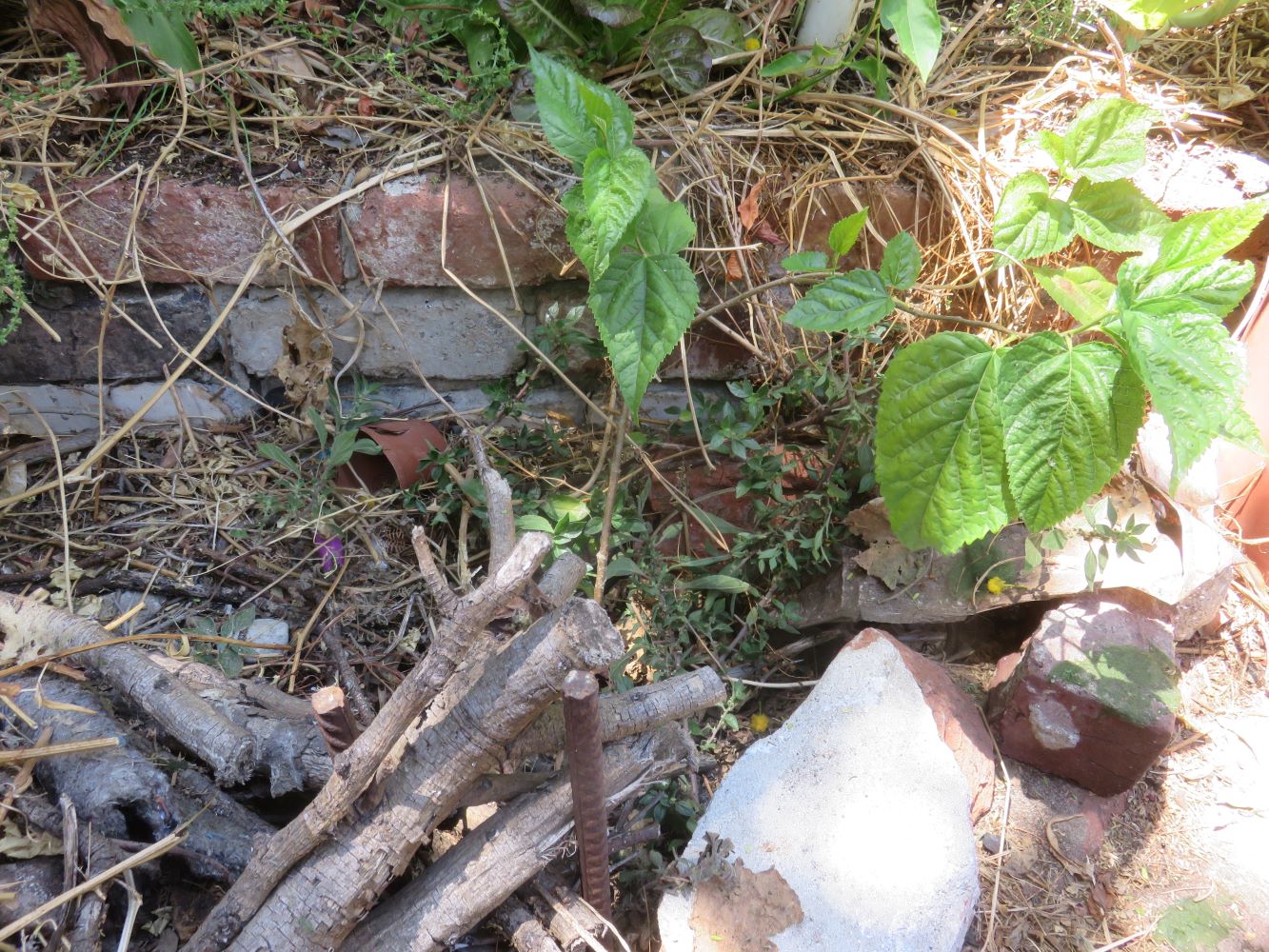 The mulberry planted in a hole in the ground surrounded by bed walls is half the age of the other, and thriving.
The mulberry planted in a hole in the ground surrounded by bed walls is half the age of the other, and thriving.A quick regenerative recap:
The more-on versus the do-nothing approach
We equate growing food with lots of digging and plenty of supplementation with irrigation and fertilizers. Regenerative agriculture decries the more-on approach, in which soil is improved in the short term by violating its integrity with ploughs and spades, while in the long term it needs more and more additives, and problems are only addressed by adding more additives, more industrial minerals, more pesticides and more water until it is utterly depleted.
Soil is truly
regenerated by reducing interference and disturbance. After all the
microbes are tiny, sensitive animals. So, not cultivating, cutting
chemical additives, diverse planting to serve all kinds of tiny
tastes and incorporating animal by products into the system should
increase the microbial diversity of the soil. This leads to the
soil's increased depth year on year, its improvement in water
retention, CEC or the ability to supply nutrients, and its increased
soil carbon content. Perhaps the most important mantra is to keep the
soil covered at all times, most importantly with plants. The science
shows that plants are major drivers of soil development with their
root exudates. Plants pour sugars into the soil to pay for the
microbe work forces to 'fix' the soil they are growing in. But once
this is accomplished, they put more of the sun's energy into their
own biomass. That is, once you have really healthy soil life, yields
will spike up. Case studies around the world of the success of no
till and regenerative farming abound. But its not a simple one size
fits all approach. The suite of practices is context dependent and
quite complex, and sensitivity is required. You need to respond to
the specifics in your environment. In the Cape we have the water
scarcity issue, the dire need for better nutrition but a
preference for European vegetables which conflicts with long term strategies for
growing food regeneratively.
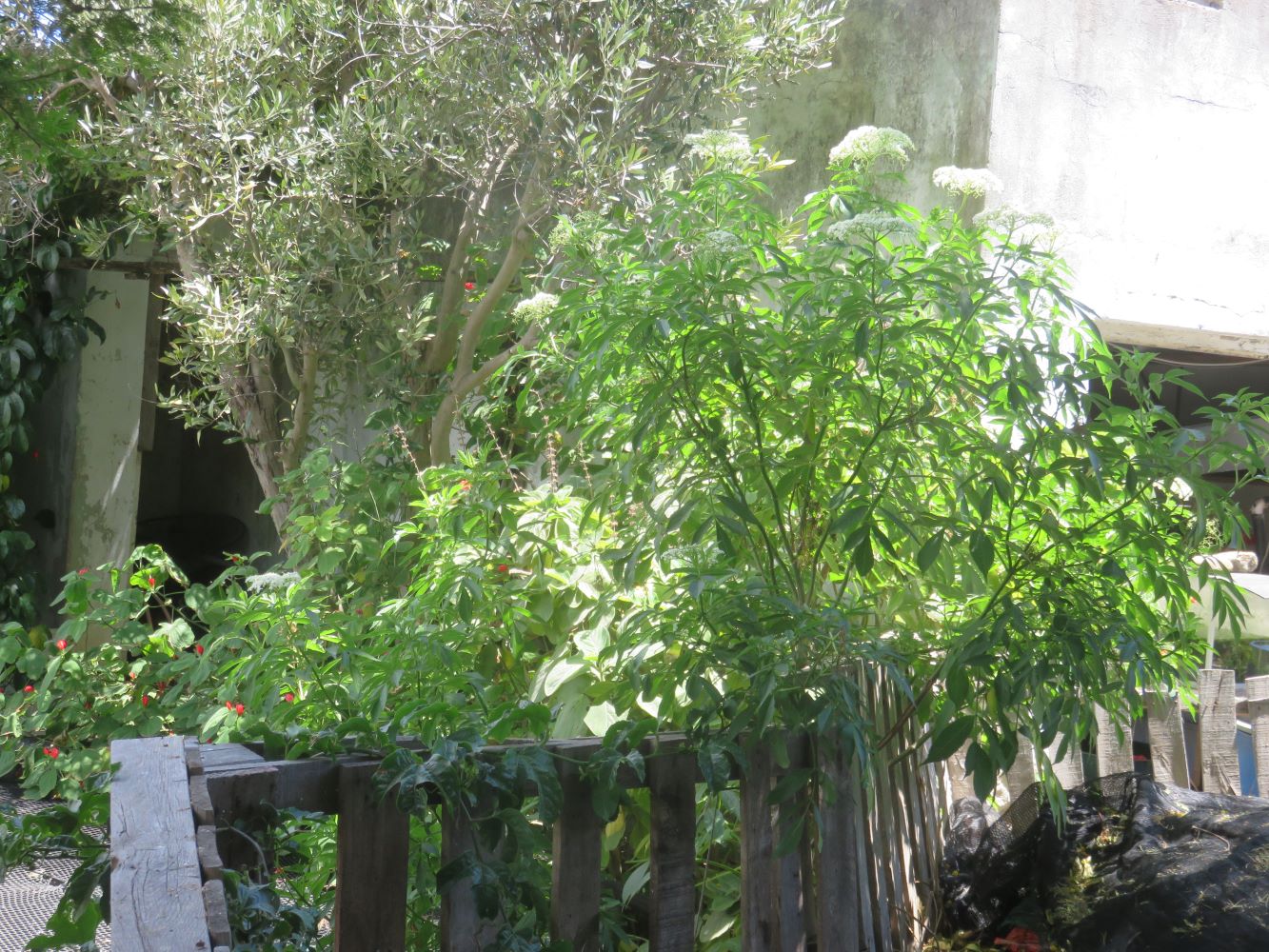 An elderberry thrives butted up to the compost heap that is frequently watered. Three clones of the same elderberry planted on the raised bed died.
An elderberry thrives butted up to the compost heap that is frequently watered. Three clones of the same elderberry planted on the raised bed died.Fixing mistakes and beyond
To boost the life in the soil, I'm beginning to see that at the Cape one needs to do all the regenerative stuff relating to soil carbon, but first to maximize the water available in the system and to do that by planting the rain. We also need massive education on indigenous foods. Its a potential career opportunity for people who've inherited this knowledge down the generations.
In following posts I will delve deeper into my experience of trying to solve the rain harvesting mess ups in my garden. Its a not a simple story. I've become very skeptical of simple universal solutions and planting lists in 'permaculture', it is not true permaculture, which is site sensitive, and very responsive. We need to be responsive before all else. It is the most important skill. It leads to relevant knowledge.
This brings me to the first and perhaps best tip to fix the situation in my garden and anyone else's for that matter. Exercise long and thoughtful observation. Watch the rain on the land and its surroundings. See where it comes from, where it piles up and where it flows to. Observe the wild plants in wilderness areas. Where do they grow on the slope and where does their water come from ? Read a lot about other people's problems sourcing gardening water. I'm learning you don't have to be that wealthy to find solutions. There is more to harvesting the rain than slapping an expensive tank under your down pipes. I'm always challenged by the need to do things at zero cost and its a very stringent and useful challenge. But more on that later.
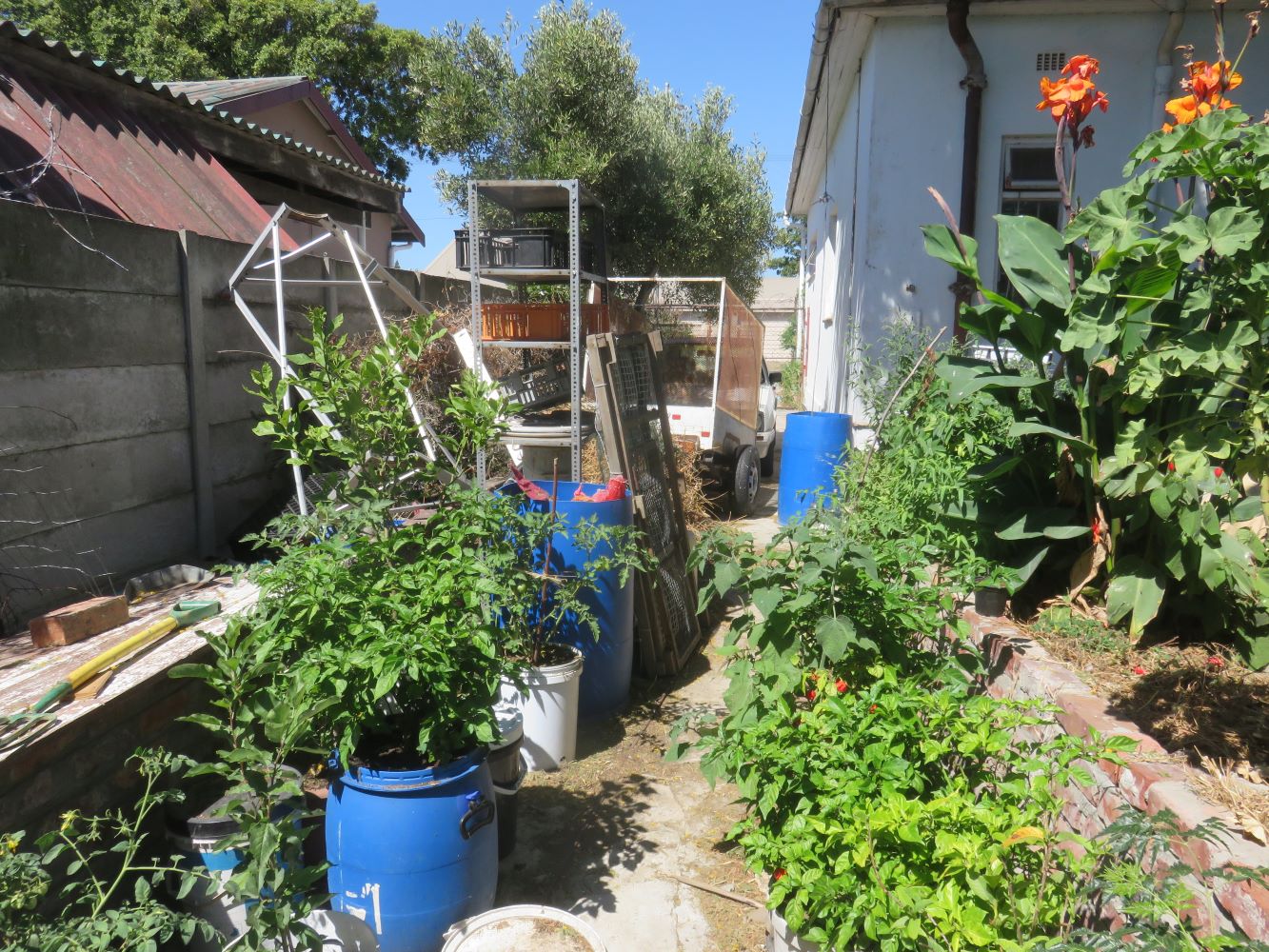 Our driveway, sixty square meters of hard concrete surface. I've recognized its potential these last four years, and I still have not thought of a way of cheaply catching and holding the runoff.
Our driveway, sixty square meters of hard concrete surface. I've recognized its potential these last four years, and I still have not thought of a way of cheaply catching and holding the runoff.------
home page for links to all my topics on regenerative and restorative gardening techniques
------
greenidiom's regenerative gardening blog
------
------
Restore Nature Newsletter
I've been writing for four years now and I would love to hear from you
Please let me know if you have any questions, comments or stories to share on gardening, permaculture, regenerative agriculture, food forests, natural gardening, do nothing gardening, observations about pests and diseases, foraging, dealing with and using weeds constructively, composting and going offgrid.
SEARCH
Order the Kindle E-book for the SPECIAL PRICE of only
Prices valid till 30.09.2023
Recent Articles
-
garden for life is a blog about saving the earth one garden at a time
Apr 18, 25 01:18 PM
The garden for life blog has short articles on gardening for biodiversity with native plants and regenerating soil for climate amelioration and nutritious food -
Cape Flats Sand Fynbos, Cape Town's most endangered native vegetation!
Apr 18, 25 10:36 AM
Cape Flats Sand Fynbos, a vegetation type found in the super diverse Cape Fynbos region is threatened by Cape Town's urban development and invasive alien plants -
Geography Research Task
Jan 31, 25 11:37 PM
To whom it may concern My name is Tanyaradzwa Madziwa and I am a matric student at Springfield Convent School. As part of our geography syllabus for this
"How to start a profitable worm business on a shoestring budget
Order a printed copy from "Amazon" at the SPECIAL PRICE of only
or a digital version from the "Kindle" store at the SPECIAL PRICE of only
Prices valid till 30.09.2023

